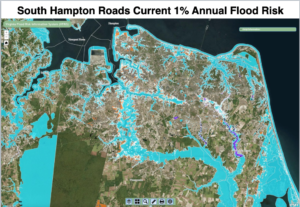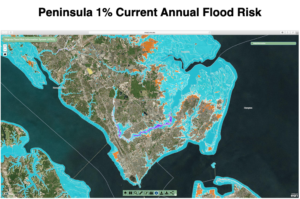Some of us, led by then-Delegate Jason Miyares, have been trying for years to establish a state authority that finally can bring regional storm surge protections to Virginia.
Now we have a chance. For whatever reasons, we could never get a governor behind the proposal.
Gov. Youngkin has stepped up and supported HB 847 (Delegate Rob Bloxom, R-Accomack, and SB 569, Senator Jen Kiggans, D-Virginia Beach).
We now have a chance.
The “Budget Amendment Necessary” and “Fiscal Impact Estimates” on those bills are both “Preliminary – Indeterminate” for this legislation. But the new authority created under this legislation cannot spend significant money without the approval of the legislative process, so the fiscal impacts of the legislation as written will be small.
The summary of those bills:
Creates the Coastal Virginia Resiliency Authority, a single state entity to develop, manage, and integrate coastal restoration and resilience.
It is modeled roughly after Louisiana’s hyper-successful Coastal Protection and Restoration Authority (CPRA). CPRA has written the original music and lyrics on how to leverage the federal government’s willingness to pay 65% of the costs of such programs as long as it has a competent partner. Texas and Florida are following Louisiana’s lead.
Finally, we hope, Virginia will follow as well.
Key phrases in the pending legislation:
The Coastal Virginia Resiliency Authority is created as a body politic and corporate, a political subdivision of the Commonwealth.
The General Assembly has determined that there exists in the Commonwealth the need for a single state entity to develop, manage, and integrate coastal restoration and resilience.
The Authority is granted all powers necessary or convenient for the carrying out of its statutory purposes.
Additional powers
2. Serve as a non-federal sponsor and enter into a legal agreement with the U.S. Army Corps of Engineers for the purpose of mitigating coastal flooding and integrating coastal resilience;
3. Enter into and execute agreements with the federal government, including the Department of Defense for support for flood control initiatives to increase the coastal resiliency related to Department of Defense installations.
This approach is the only one that has any chance of working across jurisdictional boundaries, whether coastal or riverine.
Previous administrations tried valiantly and out of necessity to get Regional Planning Commissions, which have no authority to do anything but plan, to get their member jurisdictions to agree to some form of joint executive authority.
Those efforts in Hampton Roads failed quite publicly. The local governments do not trust one another. The mayors don’t want to cede authority to a regional body.
The Corps of Engineers, without whose participation the federal purse on such projects is closed, by law may not proceed without a non-federal sponsor. Virginia has checkmated its own king. Until now, we have by lack of state action blocked consideration of any Virginia regional flood control projects that spend federal money.
The problem for coastal and riverine communities is that flood waters simply do not care about political boundaries.
This is the chance to finally take state action in a situation in which only state action will work. It starts with coastal flooding protection. Virginia’s coasts are not the only areas of the Commonwealth that flood, just the most potentially devastating. I hope this is only the beginning.
And I hope it begins getting done this year.



Leave a Reply
You must be logged in to post a comment.